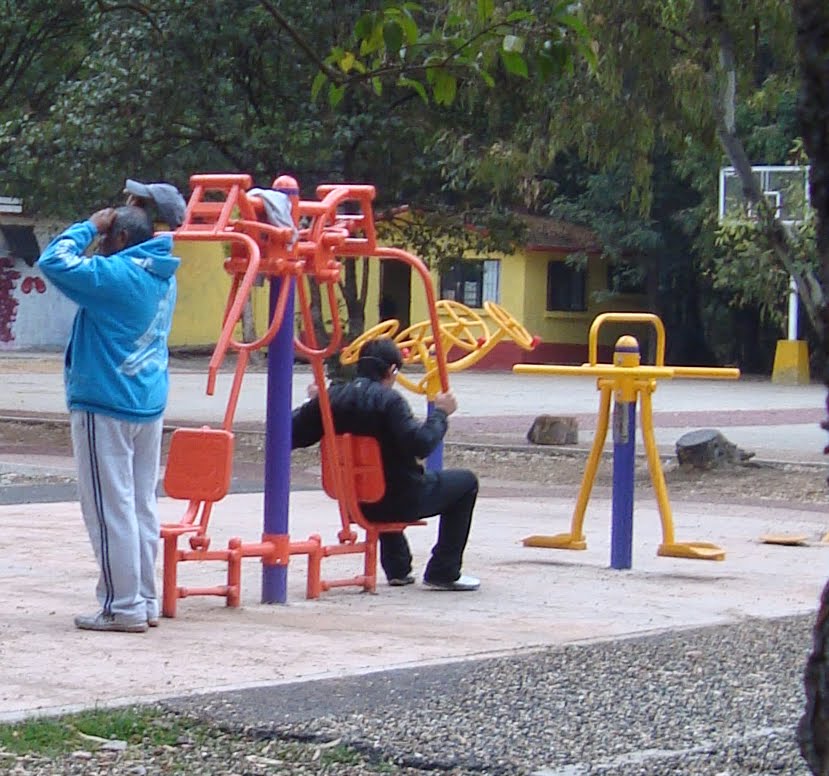Being the third largest city in the world, Mexico City is not exactly a model of sustainability. On the other hand, if 24 million people are going to congregate somewhere on the planet, it may as well be in a place with a consistently comfortable climate. Most buildings need no heating or air conditioning, which must make for a dramatically reduced demand for energy. Though Mexico sold off its passenger trains in the 1990s, and much of Mexico City is clogged with traffic, there is at least a quiet, smooth-running subway system and impressive intercity buses.
And then there are these sleak taxis, seen only at the city's center (the Zocolo) but perhaps found elsewhere as well. Mexico City was built on a drained lake bed, in fact was built over an Aztec city that was located on, and surrounded by, a lake. All of which is to say that the city is very flat, and therefore is a good spot for taxis like these, which run on batteries or can be pedaled. Princeton has examples of bicycles with battery assist, and New York City has the pedicabs, but this is the first I've seen of a streamlined fusion of pedals and electric for taxis.
Here's one of the vehicles at the Zocolo, in front of the government palace that holds Diego Rivera's murals depicting Aztec life.
An internet search reveals that they are called EcoCabs, are common in Europe and have offices in Canada and the U.S. This BikeHugger post shows one in New York City, and provides some details about the electrical component.
Another interesting vehicle seen in Coyoacan in southern Mexico City was this bus that looks like a second bus fell on top of it, upside down. A similar bus, that was fueled by biodiesel and actually was constructed of two buses one on top of the other, paid a visit to the Jewish Center of Princeton some years back (can't find my post about it).
Many parks in Mexico City include what are essentially outdoor gyms with elaborate exercise equipment, open to the public and well used. Benchpress for the People! This is one of the perks of a climate that's comfortable year-round.
Near that particular outdoor gym was the Viveros, a city tree nursery that doubles as a jogging mecca much like Central Park in NY City.
A couple times, I saw groups of bicyclists riding assertively in Critical Mass fashion.
Various bikes are adapted for freight purposes. A more common version is the tricycle in which two large wheels in front straddle a freight compartment, with the rider sitting behind over the third wheel.
Managed to add to my collection of photos of elegant settings for compact fluorescent lightbulbs.
Recycling looks haphazard, but who knows. This truck is filled with cardboard and bags of bottles and cans.
Near the Zocolo, this garbage truck remained parked for a long time while two guys loaded garbage into it, then sorted out various recyclables. This sorting is done before the trip to the landfill, reminiscent of the approach used by the highly organized and industrious "carteneros" of Buenos Aires. By contrast, in the documentary on the immense landfill outside Rio in Brazil, the sorting is done by hand at the landfill.
Most receptacles on city streets are paired as organic and inorganic. These use the same color scheme as Princeton University's outdoor receptacles. The effort to separate out organics is ambitious,
but the contents in one were indistinguishable
from the other. For people to actually pay attention to where they throw their trash, the receptacles have to have more dramatic and demonstrative body language than this.
For example, Freda Kahlo's house has what looks like a crib for collecting bottles. Everything about this receptacle sings out "BOTTLES!", which makes it hard for even the most distracted tourist to contaminate it with something else.
Even the receptacle for recycling batteries was tastefully painted with the house's famed color scheme.















No comments:
Post a Comment